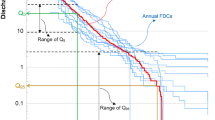Summary
Accurate estimates of rainfall intensity distribution with high temporal and spatial resolution are necessary in most urban hydrological studies, such as planning, simulation or control of sewer networks. Traditionally, these data are obtained from intensity-duration-frequency (IDF) curves at sites with long rainfall intensity time-series, however, little attention is given to the spatial features of precipitation. In this paper, a mathematical model of a local scale storm that takes account of the spatial variability of rainfall and rain-cell movement is proposed. The model has been calibrated with a dense network of raingauges and a long rainfall intensity timeseries (60 years) and its parameters have been calculated for convective storms of return periods up to 15 years with their most frequently-observed rain-cell velocities (1 to 4 m/s).
Similar content being viewed by others
References
Bengtsson, L., Niemczynowicz, J., 1986: Areal reduction factors from rain movement.Nord. Hydrol. 17, 65–82.
Bengtsson, L., 1991: Effective concentration time for moving storms in complex urban basins.Atmos. Res. 27, 137–150.
Hall, M. J., 1984:Urban Hydrology. London: Elsevier Applied Science Publishers, 299 pp.
Keifer, C. J., Chu, H. H., 1957: Synthetic storm pattern for drainage design.J. Hydraul. Div., ASCE 83, 4, 1–16.
Lorente, J., Redaño, A., 1990: Rainfall rate distribution in a local scale: the case of Barcelona city.Theor. Appl. Climatol. 41, 23–32.
Lorente, J., Redaño, A., 1991: Relation between maximal rainfall rates for different time intervals in the course of a storm.Atmos. Res. 27, 61–66.
Niemczynovicz, J., 1982: Areal intensity-duration-frequency curves for short-term rainfall events in Lund.Nord. Hydrol. 4, 193–204.
Niemczynowicz, J., 1984: An investigation of the areal and dynamic properties of rainfall and its influence on runoff generating processes.Dep. Water Resour. Eng. University of Lund, Sweden, Rep. 1005, 215 pp.
Packman, J. C., Kidd, C. H. R., 1980: A logical approach to the design storm concept.Water. Resour. Res. 16,994–1000.
Redaño, A., Lorente, J.:, Vazquez, R., 1986: Climatologia de las intensidades extremas de lluvia en Barcelona.Rev. Geofis. 42, 193–198.
Redaño, A., Lorente, J., 1990: Analysis of instantaneous rainfall rate during flash floods in Barcelona,Weather 45, 215–222.
Stewart, E. J., 1989: Areal reduction factors for design storm construction: joint use of raingauge and radar data.Proc. of the Baltimore Symposium, I.A.H.S. 181, 31–40.
Urzikán, P., Horvátz, J, 1984: Synthetic design storm and its relation to intensity-duration-frequency curves.Water Sci. Technol. 16, 69–83.
Author information
Authors and Affiliations
Additional information
This work has been supported by the DGICYT, Project NAT91-0596.
With 6 Figures
Rights and permissions
About this article
Cite this article
Redaño, A., Lorente, J. Modelling the spatial and temporal distribution of rainfall intensity at local scale. Theor Appl Climatol 47, 25–32 (1993). https://doi.org/10.1007/BF00868893
Received:
Revised:
Issue Date:
DOI: https://doi.org/10.1007/BF00868893




